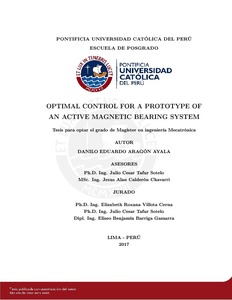| dc.contributor.advisor | Tafur Sotelo, Julio César | es_ES |
| dc.contributor.advisor | Calderón Chavarri, Jesús Alan | es_ES |
| dc.contributor.author | Aragón Ayala, Danielo Eduardo | es_ES |
| dc.date.accessioned | 2017-05-24T21:05:38Z | es_ES |
| dc.date.available | 2017-05-24T21:05:38Z | es_ES |
| dc.date.created | 2017 | es_ES |
| dc.date.issued | 2017-05-24 | es_ES |
| dc.identifier.uri | http://hdl.handle.net/20.500.12404/8675 | |
| dc.description.abstract | First applications of the electromagnetic suspension principle have been in experimental
physics, and suggestions to use this principle for suspending transportation
vehicles for high-speed trains go back to 1937. There are various ways of designing
magnetic suspensions for a contact free support, the magnetic bearing is just one of
them [BCK+09].
Most bearings are used in applications involving rotation. Nowadays, the use of
contact bearings solves problems in the consumer products, industrial machinery, or
transportation equipment (cars, trucks, bicycles, etc). Bearings allow the transmition
of power from a motor to moving parts of a rotating machine [M+92].
For a variety of rotating machines, it would be advantageous to replace the mechanical
bearings for magnetic bearings, which rely on magnetic elds to perform
the same functions of levitation, centering, and thrust control of the rotating parts
as those performed by a mechanical bearing. An advantage of the magnetic bearings
(controlled or not) against purely mechanical is that magnetic bearings are contactless
[BHP12]. As a consequence these properties allow novel constructions, high
speeds with the possibility of active vibration control, operation with no mechanical
wear, less maintenance and therefore lower costs. On the other hand, the complexity
of the active (controlled) and passive (not controlled) magnetic bearings requires
more knowledge from mechanics, electronics and control [LJKA06].
The passive magnetic bearing (PMB) presents low power loss because of the
absence of current, lack of active control ability and low damping sti ness [FM01,
SH08]. On the other hand, active magnetic bearing (AMB) has better control ability
and high sti ness, whereas it su ers from high power loss due to the biased current
[JJYX09].
Scientists of the 1930s began investigating active systems using electromagnets for high-speed ultracentrifuges. However, not controlled magnetic bearings are physically
unstable and controlled systems only provide proper sti ness and damping
through sophisticated controllers and algorithms. This is precisely why, until the
last decade, magnetic bearings did not become a practical alternative to rolling element
bearings. Today, magnetic bearing technology has become viable because of
advances in microprocessing controllers that allow for con dent and robust active
control [CJM04].
Magnetic bearings operate contactlessly and are therefore free of lubricant and
wear. They are largely immune to heat, cold and aggressive substances and are operational
in vacuum. Because of their low energy losses they are suited for applications
with high rotation speeds. The forces act through an air gap, which allows magnetic
suspension through hermetic encapsulations [Bet00]. | es_ES |
| dc.description.uri | Tesis | es_ES |
| dc.language.iso | eng | es_ES |
| dc.publisher | Pontificia Universidad Católica del Perú | es_ES |
| dc.rights | Atribución-NoComercial-SinDerivadas 2.5 Perú | * |
| dc.rights | info:eu-repo/semantics/openAccess | es_ES |
| dc.rights.uri | http://creativecommons.org/licenses/by-nc-nd/2.5/pe/ | * |
| dc.subject | Cojinetes magnéticos | es_ES |
| dc.subject | Sensores | es_ES |
| dc.subject | Prototipos (Ingeniería) | es_ES |
| dc.subject | Algoritmos | es_ES |
| dc.title | Optimal control for a prototype of an active magnetic bearing system | es_ES |
| dc.type | info:eu-repo/semantics/masterThesis | es_ES |
| thesis.degree.name | Magíster en Ingeniería Mecatrónica | es_ES |
| thesis.degree.level | Maestría | es_ES |
| thesis.degree.grantor | Pontificia Universidad Católica del Perú. Escuela de Posgrado | es_ES |
| thesis.degree.discipline | Ingeniería Mecatrónica | es_ES |
| renati.advisor.dni | 06470028 | |
| renati.advisor.dni | 43076936 | |
| renati.discipline | 713167 | es_ES |
| renati.level | https://purl.org/pe-repo/renati/level#maestro | es_ES |
| renati.type | http://purl.org/pe-repo/renati/type#tesis | es_ES |
| dc.publisher.country | PE | es_ES |
| dc.subject.ocde | https://purl.org/pe-repo/ocde/ford#2.00.00 | es_ES |






